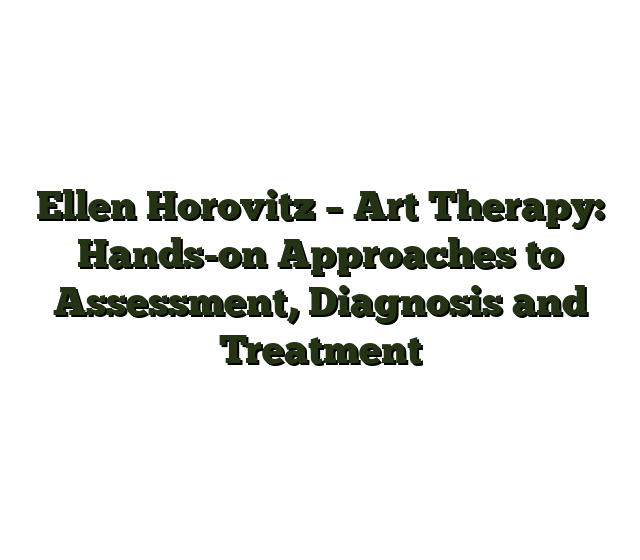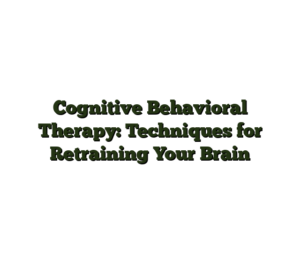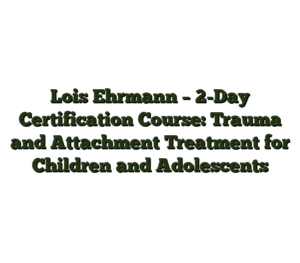Ellen Horovitz – Art Therapy: Hands-on Approaches to Assessment, Diagnosis and Treatment
Ellen Horovitz – Art Therapy: Hands-on Approaches to Assessment, Diagnosis and Treatment course is now available at an affordable price. You can check out directly using multiple payment gateway options. If you have any questions or need an alternative payment method, feel free to contact us.
Ellen Horovitz – Art Therapy: Hands-on Approaches to Assessment, Diagnosis and Treatment
Incorporate creative art therapy techniques and interventions for anxiety, PTSD, mood disorders, physical and sexual abuse, dual diagnosis, co-morbidity and more
Spot normal vs. abnormal development in art
Recognize cognitive, physical, and emotional irregularities in art
Do you have clients who are stuck, repeating the same patterns over and over and you feel powerless to help them? Are they often resistant to the interventions you offer?
Join internationally known art therapist, Dr. Ellen Horovitz, in this hands-on workshop where she will show you how to incorporate expressive art therapies into your practice in a disarming, imaginative and emotionally-safe manner.
Reach your most resistant patients with evidence-based practices that cut through an array of disorders, including mood, personality, developmental-learning, eating and body disorders. You’ll learn to identify both normal and abnormal artwork from cognitive, physical, emotional and developmental platforms. Add value to your clinical practice by learning creative art therapy modalities that succeed with individuals, couples and families.
Patient video footage of difficult case studies and active hands-on participation will demonstrate how to incorporate these assessments and modalities into your practice. No prior experience necessary!
Knowing Art Therapy
Know the ethical implications of using art therapy in your practice
Learn the psychotherapy behind the art and its language
Development and Clinical Applications
Identify normal and abnormal developmental levels of artwork, including organicity and TBI
Streamline your reports using the apps such as Genogram Analytics, BetterMind, and Limbix
Assessment: Hands on Activities
Art Therapy Dream Assessment (ATDA)
Video case study: Mourning and loss, dually diagnosed patient
Experience the ADTA firsthand
Practice how to dialogue with the patient
Belief Art Therapy Assessment (BATA)
Video case study: Mourning and loss, dually diagnosed patient
Experience the BATA firsthand
Practice how to dialogue with the patient
Cognitive Art Therapy Assessment (CATA)
Video case study: Schizophrenic spiraling into OCD moment
Learn how to redirect the patient
Experience the CATA and its importance in first art therapy session
Conducting Additional Assessments
Kinetic Family Drawing (KFD)
The Road Test
Person Picking an Apple From a Tree (PPAT)
The Bridge Drawing
Hands-on Techniques for Specific Populations
OCD and schizophrenic – fiber work
PTSD, co-morbidity – mask making
Dysmorphia, eating disorders, and more – body tracings
Mood Disorders – Breath of Joy exercises
Sexual/physical abuse survivors – co-operative blankets exercises, safe place/containers
Couple/ Family Collaborative Drawing Techniques
Aggressive, self-harming populations – 3-D exercises, paper exercise
All populations – word exercise – the bag exercise, self-esteem techniques
Bring an image of your younger self to the workshop or use a current image from your smartphone – Phototherapy techniques
Summarize the benefits of utilizing an art therapy approach in assessment, diagnosis and clinical treatment of mental health disorders.
Consider the ethical implications and clinical limitations of using art therapy modalities in treatment.
Utilize art therapy methods to identify both normal and abnormal psychological development in clients.
Articulate the methods by which art therapy assessment techniques (such as ATDA, BATA, CATA) can be utilized to improve clinical outcomes.
Incorporate art therapy interventions for identifying specific clinical issues including aggression, self-esteem, PTSD and eating disorders.
Recognize how to identify cognitive, physical and emotional irregularities in art that may indicate symptoms of anxiety and mood disorders and identify potential issues of physical and sexual abuse.
Delivery Policy
When will I receive my course?
You will receive a link to download/view your course immediately or within 1 to 24 hrs. It may takes few minutes, also few hours but never more than 24 hrs. Due to different time zone reasons.
How is my course delivered?
We deliver courses through Google Drive or Telegram. Once your order is complete, you?ll receive an email with a Google Drive or Telegram channel access link to view/download the course.
In case you submit a wrong email address, please contact us to resend the course to the correct email.
Where can I find my course?
Upon completing your order, a link to download or access the course will be sent to your email. Alternatively, you can find it in the ‘My Account’ download section.
If you do not see it there, please share a screenshot of your order and payment with me on Telegram at @ bossallcourses_bot to ensure prompt assistance. I am highly responsive on Telegram.







Reviews
There are no reviews yet.